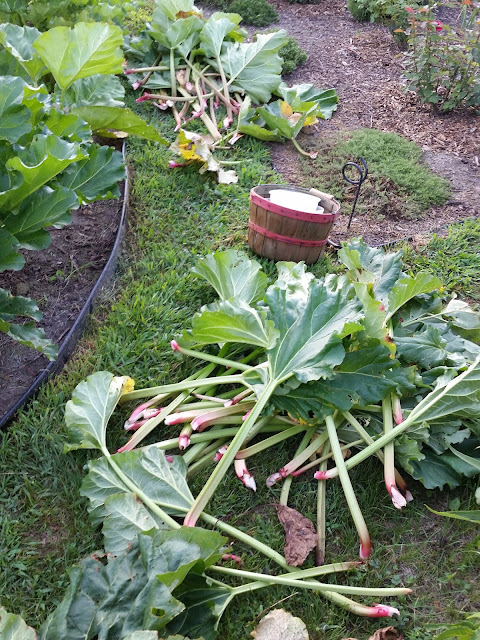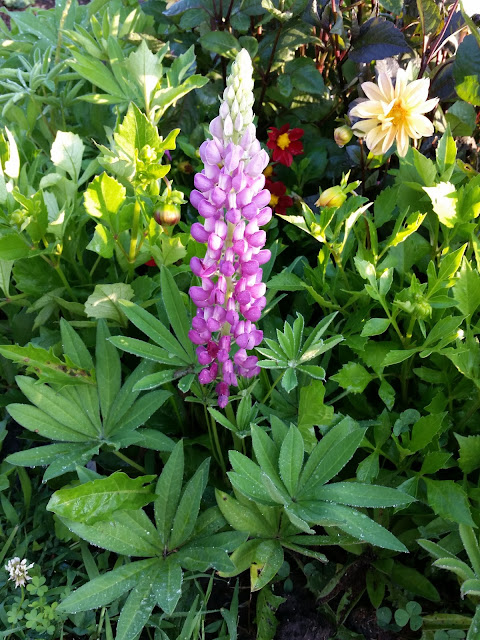So, the rain has disappeared. Most things are fine still, but I do have to hand water the little lettuces and carrots that are just coming up and the the little 'Early Jersey Wakefield' cabbage plants I recently put out.
I finally gave up on the Chinese cabbage. I haven't had any luck growing them in three years, so I don't plan to keep trying. I pulled them all out and set out some very small 'Early Jersey Wakefield' cabbages I had started from seed. We'll see how they do. Since the weather was amenable, I kept them outside since they first came up, and were fairly riddled with insect feeding.
New cabbages
I failed to get my lettuces planted in 2-week intervals, so I haven't had any since the original early spring planting wore out. I finally got around to planting more seeds on the 10th and 23rd of June, and they've been slowly coming up. I haven't been as keen to hand water in the heat we've been having, so they haven't been keen to take off.
Tiny lettuces - 'Rocky Top' mix - trying to get a start in this heat
I let the cute little head lettuce from the 'Rocky Top' mix I planted in the spring bolt so I could save some seed from it. It's finally starting to flower.
After bolting
This was it during its heyday.
The extreme heat and hot winds aged the lovely Stargazer lilies before their time. They look pretty weather beaten.
I've had to cut down the entire bunch on the right in the picture above, and the ones on the left, while only a few days old now are already looking very sad when you're up close.
Just before the hot dry spell, the plentiful rains encouraged toadstools in the mulch. They don't hurt anything, so I just leave them to dry up. They're really just a sign that the decomposition process is taking place, and that makes the soil more fertile in the end. The mulch will have mostly broken down by the end of the season.
The 'Henderson's Bush' lima beans that I direct sowed on June 9 are lush and getting ready to flower. The okra is about shoulder height now and producing loads of pods. The Japanese beetles like it, so twice a day I go out and pick them off. When will they ever quit?!

'Henderson's Bush' limas (foreground); 'Jing Orange' okra (middle left)
'Golden zucchini', 'Marketmore' cucumbers and 'Black Beauty' tomato on a trellis (middle right, left to right)
None of the stalks are red, but I'm expecting that when the weather turns cool in the fall, 'Cherry Red' and 'Holstein' - the two new varieties I started from seed this year - will turn color.
I harvested some of the yellow onions, and one 'Missouri Pink Love Apple' tomato, as well as another 'Golden zucchini' that got away from me. They hide well! They're still good for chopping up and freezing to put in winter soups.
'Missouri Pink Love Apple'
This is the first ripened tomato of the year (aside from the currant size ornamental ones). This particular one appears to be two tomatoes that fused into one. Siamese twins. I still have lots of large green tomatoes on every plant (three different varieties) that don't seem to be in any hurry to ripen. I've read that tomatoes ripen between the temperatures of 50 and 80F. That doesn't give them lots of time in these days where daytime temperatures are in the 90s from fairly early in the morning until after the sun goes down.
But the plants are healthy! They're topping out over their cages, and I'm going to be clipping their tops so I don't have the tangled mess I had last year.
'Black Beauty' - a purple variety that I've not grown before, is interesting in that some of the yet unripe tomatoes are almost black all round, some all green, some green and black, and some are green and purplish. I'm eager to see what's inside.
I haven't had a lot of tomato hornworm damage this year. Thank goodness. Because, it's bad enough when they start decimating the tops, but when they take bites out of the tomatoes, it's maddening. I didn't notice this one until it was too late:
Summer's always a time of sharing with the bugs. I rarely see the Green June beetles (Cotinis nitida), but this year, a couple of them exposed themselves (to their detriment). Sometimes they're solid metallic green, and sometimes they're green and beige. These were one of each.
June beetles are mainly a pest of turf in their larval (grub) stage and nothing to worry about on vegetables and ornamentals.
Of course, some insects are very welcome. Like this Viceroy butterfly. Viceroys look very much like Monarchs, but the easiest way to tell the difference is that Viceroys have a black line parallel to the edge of their hind wings. Somewhere once upon a time I heard that the Viceroy has only one row of white spots on the edge of the wings, but that's not true. Here's a site to help tell one from the other.
I planted some butterfly milkweed, which is the only plant that the Monarch larva (caterpillars) feed on. The adult butterfly gets its nectar from other plants. The butterfly milkweed I planted next to an old butterfly house has already grown about waist high. I hope to collect seed and plant more, and do the same in following years. Maybe if I get enough planted, I'll also get some Monarchs coming through. Frankly, I don't know. I suspect that if there isn't already an established route through here, they're not likely to venture in.
But, back to pests. There was a beautiful male cardinal driving me crazy for the last month. He'd sit outside my bedroom window in a Cypress tree and constantly toss himself against the glass. He'd start as soon as the sky showed some light, waking me up each morning, and continuing on and on without resting. He drove me nuts when I was on my computer - about four feet away from the window, just far enough out of reach that after he got used to me waving a plastic bag to run him off, I would have to actually get up from my chair and go to the window to send him flying away. And then he would be back in a few minutes.
I finally found something that has kept him away.
Thank you, Hugh Jackman.
I didn't get many Lupine plants from the seeds I ordered, but the ones I did certainly make a lovely addition to my cut flower garden.
The 'Black Pearl' pepper seed I saved show that the plant is a hybrid. The parent plant had nearly black leaves and little round peppers that progressed from black to green to bright red. The seeds produced plants that have either green leaves with cone-shaped small purple peppers to black leaves and peppers somewhere between round and cone-shaped.
'Black Pearl' offspring
'Black Pearl' parent
This is why when you see a plant you just love somewhere, you can't always take away some seed and get what you're expecting. Taking cuttings from them for rooting will always produce the same as the parent plant - you're cloning it. Alas, I didn't get a cutting from this gem. And even if I had, I wasn't set up with a good overwintering spot. I plan to remedy that problem this winter by erecting a small portable greenhouse against the south side of the house. That will still leave me with some logistical issues, but it will be better than trying to keep things alive and in good health in the cellar. For things that at least go somewhat dormant if left outdoors, that works fairly well. For tropicals - not at all.
I still have a few plants from the seeds of the parent 'Black Pearl' that are coming on and have black leaves. If one of them has the desired fruit, I'll get cuttings this time. And if not, I still have lots of seeds to try again.
I'm so happy that the one survivor from the three 'Shazam!' roses I planted two years ago is doing very well in my new rose garden. They apparently just did not like the place I originally planted them. I think it got too much shade. And, maybe, the survivor just finally got a big enough root system to really show off.
'Shazam!'
I may have chosen the wrong spot for the orange creeping thyme, though. It's on the low end of my rose garden. I've known from the past three years' experience with it in the vegetable garden that it doesn't like to be wet. I thought it was high and dry enough where I planted it, but apparently not when it's rainy like it was earlier this year. It had grown to about three times the size it was when I planted it there last fall, but now almost half of it has died back. Hopefully there are still some nodes at the crown under that dead portion to sprout out again.
The Lisianthus are blooming nicely, and if I recall, they will bloom all summer.
Hooray! One of the "red" ones made it. I've never seen this color before. Sweet.
Till next time. Stay cool.




























0 comments:
Post a Comment
Many thanks for your interest and your comments.